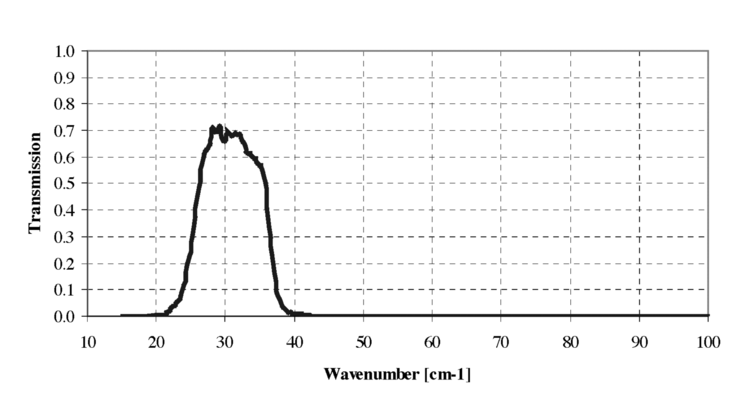
V.B.2.b.iii. Spectral and Photometric Imaging Receiver
The SPIRE instrument is a bolometer detector array instrument with an imaging photometer and an imaging Fourier Transform Spectrometer (FTS). Rather than the Ge:Ga 2 K photoconductive arrays used in PACS, this instrument is based on arrays of 'spider-web' Ge bolometers. This eliminates the long wavelength cutoffs of the photoconductive detectors , but to obtain the required sensitivity (~3 x 10-17W/Hz- 1/2) the detectors are operated at 0.3 K via a closed cycle 3He sorption refrigerator.
SPIRE's photometer mode (Δλ/λ~3) provides broadband response simultaneously in bands centered on 250µ, 350 µ, and 500 µ, with arrays of 149, 88, and 43 elements, respectively. Since the bolometers are broadband detectors, the pass bands are determined by a series of filters and dichroic beam splitters. Figure V.B.2.b.iii-1 shows a typical response for the 350 µ band. Again, as with PACS, this low resolution response is designed for the study of the broad emission features of distant galaxies.

Figure V.B.2.b.iii-1 Transmission response for a typical 350µ photometer band.
In its spectrometer mode, SPIRE uses an FTS to obtain resolution which can be adjusted between 0.04 - 2 cm-1 (λ/Δλ from 20 - 1000 at 250 µ). It has two separate detector arrays of 37 and 19 elements to cover the 200 - 200 µ and 300 - 670 µ bands, respectively.
The main scientific goals of SPIRE are deep extragalactic and galactic imaging surveys. Because the bolometer arrays make possible imaging surveys to longer wavelengths than PACS, SPIRE provides an important compliment in the spectral region where distant galaxies, with large red shifts, are expected to radiate much of their energy.